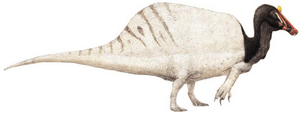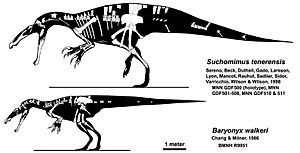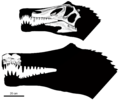Spinosaurids facts for kids
Quick facts for kids Spinosaurids |
|
|---|---|
 |
|
| Skeletal reconstruction of Spinosaurus aegyptiacus, National Geographic Museum, Washington, D.C. | |
| Scientific classification | |
| Type species | |
| Spinosaurus aegyptiacus Stromer, 1915
|
|
| Subgroups | |
|
|
| Synonyms | |
|
Spinosauridae (say: Spine-oh-SAWR-ih-dee) means 'spined lizards'. This is a group of meat-eating theropod dinosaurs. They lived during the Jurassic and Cretaceous periods. What makes them special is their lifestyle. Unlike most meat-eating dinosaurs, spinosaurids spent a lot of time near water. Their diet was mostly fish.
Fossils of spinosaurids have been found all over the world. This includes places like Asia, South America, Europe, Africa, and Australia.
Contents
What Did Spinosaurids Look Like?
Spinosaurids had longer arms than most other theropods. Their first finger often had the biggest claw. They had jaws that looked a lot like those of crocodiles. Their teeth were long and shaped like cones. These teeth were perfect for catching and holding onto prey, especially slippery fish.
Because they trapped their food, their teeth usually did not have sharp, knife-like edges. Many other meat-eating dinosaurs had these sharp edges, called serrations, to tear meat.
The most famous member of this family is Spinosaurus. It was the first spinosaurid ever found. It is also the largest meat-eating dinosaur we know of! Scientists think Spinosaurus could grow up to 15 meters (49 feet) long. That's as long as a school bus!
How Spinosaurids Lived
In 2010, a study by Roman Amiot and his team found something amazing. Spinosaurids lived a semi-aquatic life. This means they spent time both in water and on land. They lived in places similar to where hippopotamuses, crocodiles, and turtles live today. This made them very unusual among other theropods.
This watery lifestyle also helped them avoid fighting with other big predators for food. For example, Carcharodontosaurus lived at the same time as Sigilmassasaurus and Spinosaurus. But they didn't compete for food. The spinosaurids ate fish. Carcharodontosaurus mostly hunted smaller dinosaurs on land.
How Spinosaurids Are Grouped
The family "Spinosauridae" was named by a German paleontologist named Ernst Stromer. He named them in 1915. Stromer was the one who discovered the first dinosaur in this group, Spinosaurus.
As scientists found more fossils of its close relatives, the family was divided. It was split into two smaller groups, called subfamilies: Baryonychinae and Spinosaurinae. This split was made because of differences in their skulls and teeth.
Scientists use something called a cladogram to show how different dinosaurs are related. Here is a simplified cladogram from 2017. It shows how spinosaurids fit within a larger group called Megalosauroidea.
| Megalosauroidea |
|
|||||||||||||||||||||||||||||||||||||||||||||||||||||||||||||||||||||
Images for kids
-
Comparing a spinosaurid skull with that of Dubreuillosaurus and two modern pike conger eels
-
A reconstructed Irritator skeleton attacking a pterosaur at the National Museum of Rio de Janeiro
-
A reconstructed front leg and hand of Suchomimus at the Museum of Ancient Life in Utah
See also
 In Spanish: Espinosáuridos para niños
In Spanish: Espinosáuridos para niños

















